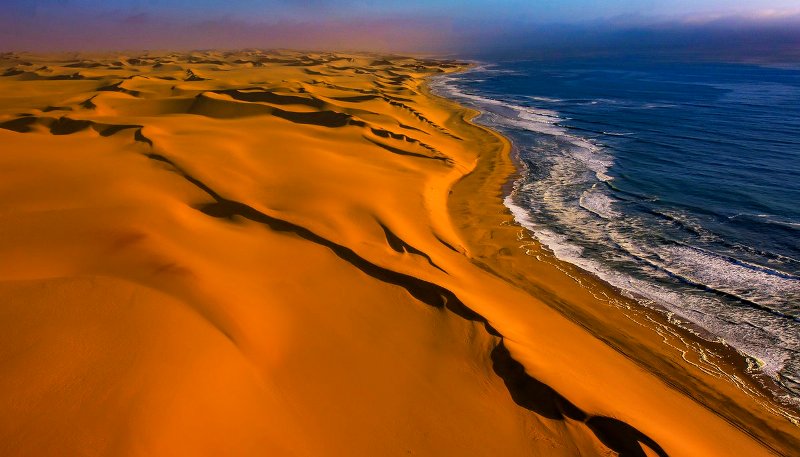Have you ever heard about a place where the famous Namib Desert meets the Ocean? Namibia’s coastal deserts lie along the Atlantic coast of Africa towards the southwest. This UNESCO World Heritage Site is famous for its high sand dunes and the point where the desert meets the sea. One of the driest places on earth is the Namib Desert. Namib means “vast place” in the Namib language.
Its Mars-like landscape is characterized by high sand dunes, barren mountains, and gravel plains covering about 81000 square kilometers across three countries. The unique desert, the dominant feature, is an arid environment characterized by towering sand dunes, dry riverbeds, and empty canyons. It is often described as lonely or bleak due to its vast stretches of empty beaches and dunes.

Namib desert is the world’s oldest desert, believed to be 55 million years old. The climate conditions are really harsh here. It can get as hot as 45 degrees Celsius during the summer, and as cold as minus 20 degrees during the night. Due to harsh weather, it appears that humans cannot live in the Namib Desert.
Despite this, some living beings have managed to adapt to this desert, including ostriches, antelopes, rodents, and birds. You will find hundreds of seals surfing the ocean waves, or just basking in the sun, spotting dolphins, whales, and mola-mola, hearing the distinct call of the jackal roaming close by the lodge, and observing their playful nature.

There are so many dunes in Namib that they actually change the direction of the prevailing winds from the south to the southwest. These dunes are the second highest in the world, standing over 900 feet high at their tallest. Researchers and scientists from all over the world have been fascinated by the geomorphic phenomenon called fairy circles found in the Namib Desert. This type of grass encircles barren patches of sand also known as fairy rings.
Aliens may have been involved in the formation of the fairy circles, but no evidence supports this theory. Reptiles and mammals living in the desert area of Namib get their water from fog, which means they have evolved a way to survive with less water consumption. For more than 180 days each year, dense ocean fog obscures the dunes and beaches, making a visit to this desert a misty experience.

A layer of iron oxide covers the sand in the desert, giving it its reddish color. Different parts of the desert have different colors of sand. Also known as star dunes, the sand dunes of Sossusvlei are located in the Namib region. Due to their star-like shape, the sand dunes are quite immovable because of the wind from all directions.
A pinkish color is associated with the sand near the inland, while white color is associated with the sand near the sea. It is a sight to see when the Tsauchab River flows to the pan during an unusually heavy monsoon season. The ocean winds also bring shifting sand dunes – an environment often referred to as a “dune sea.”

The cold Atlantic waters produce cool sea breezes that keep shore temperatures mild, despite the intense sunlight and arid desert climate. The current also attracts plankton and large schools of fish and whales, resulting in an environment teeming with sea life.
You can also experience the best of the Skeleton Coast’s attractions on a beach landing at a key shipwreck or sand dunes. Namibia desert beach is a lifetime experience.
Read More – Brazilian Sand Dunes Transform into Majestic Turquoise Lagoons











